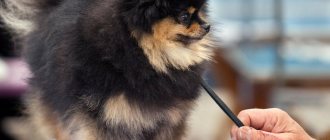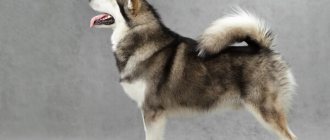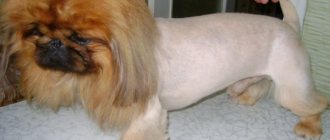What is the tail for?
Firstly, this “appendage” acts as a steering wheel and a gyroscope in one bottle. Simply put, it helps the dog maintain balance and maintain direction of movement. Take a close look at your pet at the moment when he runs - you will immediately see how actively the animal helps itself with its tail. This is especially pronounced during sharp turns, running in circles and other complex “maneuvers”.
The tail is also very important when swimming: it plays the role of a rudder , with which the dog chooses the direction of movement. The importance of the organ is especially clearly visible if you compare the “buoyancy” of an ordinary dog and a representative of a breed whose tails are docked. So, swimming is difficult for boxers. True, in recent years, tails have been docked less and less, so that dogs are not deprived of an important organ.
Secondly, this part of the body plays an important role in transmitting odors . Experienced breeders know that there are paraanal glands on the loin of any dog. Their main purpose is to release a special lubricant that helps the animal during the act of defecation.
Their other function is the release of special odorous substances that serve the purpose of “non-verbal communication”. By the way, it is precisely for the sake of spreading this smell that self-confident dogs actively wag their tails when meeting their relatives. Finally, “scents” serve as a “passport” for dogs: by their characteristics, other animals learn about the age and social status of their opponent.
On the contrary, if the dog is frightened by something or is very unsure of himself, he diligently tucks his tail under his stomach . So the animal diligently tries not to attract undue attention to itself. But! Similar signs can also be seen in pets suffering from inflammation of the anal glands (also called sinuses). This pathology is very painful and can lead to serious consequences, and therefore we recommend that you immediately consult a veterinarian.
Inflammatory pathologies, tail wound infections
The most common “tail” pathologies are inflammatory reactions of infectious origin. The tail, given its location and functions, is often injured when caught in the door. In addition, dogs may bite as a joke while playing. If the skin on this part of the body is safe and sound, there is nothing wrong with that... But in cases where there were already scratches and hangnails on the skin of the tail, playing can lead to the ingress of pathogenic or conditionally pathogenic microflora, the activity of which will certainly cause an inflammatory process.
The clinical picture is simple - the affected part of the body is noticeably swollen, in most cases there is a discharge of purulent exudate (which sticks the fur together into untidy “icicles”). You will probably notice that your dog is holding his tail in some strange way and is very resistant to attempts to examine it. With severe inflammation, an intermittent fever often develops, appetite is reduced or completely absent, and upon palpation it is easy to find a soft, dough-like swelling (if the dog does come into your hands).
During a veterinary examination, it is very important to identify the specific pathogen that caused the inflammation: different microbes have different sensitivities to antibiotics, and therefore the treatment will be different. The diagnosis is made after a visual examination of the tail; additional samples of pathological material are taken for microscopic examination and seeding on nutrient media. As a rule, broad-spectrum antibiotics are prescribed for treatment.
Treatment
First, you need to thoroughly clean the area, removing all the hair around the inflammatory focus. The fur collects infectious material and can recontaminate the wound. In addition, a cleaned wound is much easier to inspect. The hair must be trimmed using sharp nail scissors. This must be done extremely carefully, avoiding the appearance of cuts (they will be re-contaminated with pathogenic microflora).
After trimming, it is necessary to treat the hair-free skin with disinfectant compounds (a regular alcohol tincture of iodine will do). Solutions should not be allowed to enter the wound canal.
If the suppuration is not too severe, the tail can be washed. To do this, you don’t need to bathe the whole dog: you just need to put the affected part of the body in a bowl of warm water, soap the affected area, rinse everything thoroughly, and then wipe dry with a clean towel.
You cannot squeeze out the pus, as this can easily introduce an infection into the blood.
If the wound is already open, then after cleaning it, place a gauze pad soaked in Vishnevsky’s balsamic liniment on top (it draws out pus and decay products very well). The bandage is attached to the tail using a plaster or tightly bandaging the affected area. It should be changed at least once a day. If the dog is active and constantly tries to “chew” the bandage, it is advisable to use a surgical collar.
How to bandage your tail correctly
As we have already said, balsamic liniment (as well as synthomycin liniment) perfectly draws out pus. In addition, these “simple” drugs perfectly suppress inflammatory processes. The only problem is that the ointment should be applied under the bandage, but how to apply it to the tail? The situation is aggravated by the fact that many dogs do not want to wear such “decoration”.
But everything is completely solvable: if you apply the bandage correctly, your pet (most likely) will not be able to rip it off. First you need to apply a gauze pad soaked in the medicine directly to the affected area. However, this can be done later: you need to start bandaging from the tip (at least closer to it), often overlapping the bandage.
Try to keep the bandage tight enough to stay on the tail, but at the same time, do not allow it to compress the tissue too much, interfering with the process of normal blood circulation. We emphasize once again that the bandage should be changed at least once a day, since otherwise the bandages will tightly “stick” to the skin, and therefore it will not be possible to remove them without loss.
If your pet constantly chews on the bandage while trying to remove it, you should either use a surgical (aka “Elizabethan”) collar, or constantly lubricate the bandages with something bitter. Wormwood oil is a good choice, as it also repels fleas well.
Important! When suppuration is just beginning, do not under any circumstances try to open the inflammatory focus, do not try to squeeze out the pus from there! Your actions will only lead to a worsening of the animal’s condition and may well provoke the development of sepsis.
Tail frostbite
Also a fairly common type of pathology. They are especially typical for dogs that spend most of their lives outdoors, as well as for representatives of “pocket” and short-haired breeds. The clinical picture is largely the same as in the previous case. The dog tries not to wag its tail too much, holds it in an unnaturally strange position, and when trying to palpate it, begins to whine or even growl, trying to escape from the “execution.”
If the dog’s tail has been frostbitten for a relatively long time, the hair on the affected area falls out, the skin takes on an unnatural color, and there may be blisters, ulcers, and other types of damage. The local temperature is elevated and there are signs of swelling. If you try to palpate the affected area of the body, the dog will try in every possible way to avoid this procedure.
In cases where the animal has just frostbitten a section of the tail, you may notice paleness of the skin, the integument in this place acquires a well-defined bluish tint. At first there is no pain, but it appears after a while when your pet is warm. And it sometimes happens that the dog constantly whines and howls pitifully.
Treatment
Advanced frostbite, when the tail is already inflamed, is treated in the same way as ordinary inflammation.
Important! “Treating” frostbite with hot water is not acceptable. Do not pour it on the affected tail under any circumstances, as the consequences can be much more serious than frostbite itself.
- It is necessary to cut the hair from the affected area , and then treat the skin with slightly warm water. It should not be rubbed or massaged.
- The animal must be kept in a room at room temperature , avoiding additional hypothermia.
- Regardless of the initial cause of tail inflammation, it is highly advisable to limit the mobility of this part of the body.
Exterior
There are several important differences in this category:
Head
The muzzle of the European variety is elongated and similar to that of a fox, with pointed ears spaced close to each other. The transition from the frontal to the facial part is not clearly expressed. Pomeranians have a rounder muzzle and more bear-cub-like appearance, with miniature ears spaced wider apart. The ratio of the facial and frontal parts is two to four.
Teeth
European standards require German Spitz dogs to have a full set of teeth, forty-two in total. The American Association is more lenient and considers it not critical if a representative is missing some molars.
Tail
The tail of the German breed is curled, sometimes in two rings, and perpendicular to the spine; the tail of the Pomeranian is straightened and always lies on the back.
Rice. 4. German and Pomeranian Spitz
These are the main differences between German and Pomeranian Spitz, which should guide you when choosing a breed. It is also important to remember that when buying a puppy, the future owner must pay attention to the presence of a metric confirmed by the canine association.
How to care for a Spitz puppy's coat: basic rules
How and what to feed a Japanese Spitz
Related Posts
Mechanical injuries to the tail
Dog tail injuries are an extremely large and very common group of pathologies. They are especially characteristic of animals with long and flexible tails. Dogs may well break them or get severely bruised by excessively expressing their emotions and violently waving their tail in all directions. As a rule, the very tip suffers, but there are cases when the organ breaks literally at the very base.
The problem is that the dog can constantly lick and even comb the affected area, which is why inflammation of an infectious nature is layered on top of the usual mechanical injury. That is why there are often situations when a dog loses its tail after receiving a seemingly insignificant injury.
In these cases, it is more the fault of the owners who did not bring their pet to the veterinarian on time, or did not follow even the basic recommendations of a specialist. If the tail is broken and severe purulent (or even necrotic) inflammation is observed at the site of injury, it is recommended to immediately amputate the affected part of the body.
First aid and treatment at home
Minor injuries can be treated at home (but we would still recommend having your dog examined by a veterinarian).
- First you need to “clean” the affected area , carefully removing all hair and dirt that interfere with normal access to the wound.
- Examine it carefully : if bones or their fragments are clearly visible in the thickness of the wound canal, further “amateur activities” should be stopped immediately and immediately seek help from a veterinarian.
- If you see that nothing serious has happened to your pet, further treatment is carried out in the same manner as already described above.
- In case of severe damage to the caudal vertebrae, the affected part of the body is simply amputated; in other cases, they are limited to applying a plaster cast or simply a tight bandage. The vertebrae of the tail fuse quite quickly, so there are no special problems.
Anti-inflammatory corticosteroids can be prescribed to relieve swelling and relieve inflammation. To speed up bone fusion, you need to feed your dog a balanced diet containing all micro- and macroelements, as well as vitamins. During this period, we strongly recommend reducing the number and duration of walks: the less the dog moves its tail, the faster it will heal. If signs of inflammation develop, antibiotics will be prescribed in addition to corticosteroids.
Necessary actions
The most important thing is to understand the origins of the problem; you should observe the pet’s behavior. It is important to note in what situations the animal behaves this way:
- when you have done something wrong;
- scared;
- feels bad.
When a dog gets scared, it is necessary to change the situation. Create a quiet, pleasant atmosphere and observe how the dog’s behavior changes. It is not recommended to drop everything and calm the dog down, feed him, stroke him and caress him. He may misjudge the owner’s behavior, because if the animal is petted, it means he did something good that the owner liked. In this case, the dog will continue to tuck its tail between its legs at every opportunity and wait for affection and treats.
You just need to distract the dog and relieve nervous tension. You need to act as if nothing happened and ignore the situation. You can do something interesting that will awaken the dog’s curiosity, and he will switch from his own experiences to what is happening. If you understand that this behavior is not associated with fear or other psychological problems, then you should conduct a thorough examination of the animal.
Examination of the animal
Most likely, the animal squeezes this organ between its paws due to the existing discomfort. Perhaps something is bothering him or hurting him. In this case, a timely examination of the dog will help detect the problem and become a reason to contact a veterinarian. What can you do yourself at home?
- Carefully palpate the animal’s belly, check for swelling or lumps.
- Use targeted pressure to check the spine; if the animal becomes more painful, this will certainly manifest itself in whining or sudden movements.
- Inspect the tail and the space under it, it is possible that there is inflammation or damage in this area.
- Look into the animal's mouth, it is quite possible that it is worried about a rotten tooth, examine the gums for inflammation.
- Take your temperature.
If a visual inspection does not produce results, then you can try giving the animal an anesthetic or anti-inflammatory. It is important to constantly monitor the animal, monitor what it eats and drinks, and how it reacts to the owner’s approach. If there is no improvement, you should seek help from a veterinarian. The latter will conduct a qualified examination, take the necessary tests and diagnose the animal.
Based on the above, we can conclude that dogs tuck their tails for a variety of reasons (if they tuck their paws, then that’s different). In order to find out the true cause and somehow help the pet, it is necessary to carefully monitor its behavior and avoid stress. If it is necessary to contact a veterinarian in a timely manner, dogs do not know how to talk and thus convey to us about their condition.
Currently reading:
- Games to choose for training a dog
- Recommendations for obedience of a dog if it growls
- Seven Signs and Remedies for Getting Rid of Fleas in Dogs
- Why does a dog bite and how to stop it from doing so?
Seborrhea
If your pet’s tail begins to smell unbearably like “dog”, and the hair on this part of the body has matted and become very greasy, then we are most likely talking about seborrhea. Most often, this disease does not develop out of the blue. Allergic reactions, infections, and other negative environmental factors lead to its appearance
It is necessary to show your pet to a veterinarian as quickly as possible: only he will be able to determine what exactly caused the development of the disease.
Treatment
Accordingly, the treatment of the pathology depends on this: antihistamines, anti-inflammatory corticosteroids, antibiotics, antifungal drugs - all this can be prescribed based on the identified root cause.
The exception is primary seborrhea. It is treated by constantly washing the tail with special antiseborrheic shampoos, and sometimes therapy is supplemented with anti-inflammatory corticosteroids.
Cauda equina syndrome
The so-called “cauda equina” is one of the most serious diseases of dogs. The problem is that its appearance indicates some serious pathologies of the whole organism. One of their manifestations, as the name of the disease suggests, is a drooping tail, reminiscent of a horse's tail. The dog can no longer wag it, cannot collect it into a “donut”. In advanced cases, the tail simply hangs, as if an old rope was glued to the dog’s spine.
The appearance of such signs does not bode well: at best, they indicate “simple” discospondylitis (inflammatory disease of the intervertebral discs), at worst, to degenerative pathologies of the neuromuscular system or oncology.
If your dog has a drooping tail, has difficulty getting up in the morning and can only walk with a “drunk” gait, you should immediately take the animal to a well-equipped veterinary clinic. Only an experienced specialist can find out the reason for what is happening. Delay is fraught with major problems, including complete or partial paralysis of the dog’s entire body.
Treatment
Treatment is complex and depends on the underlying cause identified. Often several complex surgical operations and a long (most likely lifelong) course of therapy are required.
Types of tail diseases
A dog's tail is perhaps one of the most active parts of an animal's body, so it is not surprising that it, like the entire body, is susceptible to diseases of various origins. Since there are quite a few diseases, let’s look at the most common ones.
Mechanical damage
A dog can damage its tail while wagging by hitting it against a wall, door frame, or other hard object. This usually ends in a bruise. But in some cases, a dislocation or even a fracture is recorded, then treatment of the tail is necessary. If the integrity of the skin on the tail is damaged for any reason, the damaged area without proper treatment can fester and cause more serious diseases, for example, the appearance of ulcers and the further development of eczema.
"Dropping Tail"
Owners of hunting breeds, such as beagles, know about this disease better than others. The manifestation of the disease is that the tail hangs and practically does not move even when the dog moves. Veterinarians have not yet established the exact cause of the disease, but believe that it may be due to muscle fatigue. In addition, a “drooping tail” can be a reflection of diseases of the spine and some internal organs.
"Greasy Tail"
This disease occurs not only in dogs, but also in other representatives of the animal world. The disease manifests itself in the following way: the tail becomes greasy, the hair may become matted. The main reason in this case is the hyperactivity of the tail sebaceous glands, as a result of which all the secretion produced remains on the fur. Treatment is prescribed by a doctor only after determining the cause of increased secretion production. Before diagnosis, owners simply need to wash the tail with special shampoos.
Neoplasms
All organs and parts of the animal’s body are susceptible to the appearance of tumors, which over time can degenerate into malignant ones. The tail is no exception. As a rule, until the moment of exacerbation, the disease is asymptomatic. A barely noticeable compaction first appears on the tail, which grows rather slowly. There is only one treatment method in this case - removal.
Baldness
Most often, such problems occur in older dogs. There may be several reasons. Firstly, excessive sebum production. It completely clogs the pores, preventing the hair follicles from receiving oxygen, causing the hair follicles to die. Secondly, eczema and various purulent and ulcerative lesions can be the cause of hair loss. In addition, baldness is sometimes explained by a common allergy, for example to food.
Bumps on a dog's tail
The formation of a lump on a dog’s tail may be due to the following reasons:
- Benign and malignant tumors (especially in old animals).
- Injuries. Very often, pets with long tails suffer in fights, get their tail pinched by doors, or get caught in the spokes of bicycle wheels. Bumps form at the site of healed lesions.
- Consequences of fungal invasions. The activity of pathogenic bacteria often leads to the formation of dense, lumpy growths on the affected organ.
- Old, “stiff” hematoma. Such formations become denser over time, sprouting connective tissue and becoming saturated with mineral salts.
- Individual characteristics of the animal , defects in the anatomical development of the tail.
Treatment
In all cases, treatment depends on the immediate cause of the lump. There is no general “recipe”, but general recommendations are as follows:
- If the lump is of traumatic origin , then cold is applied to it in the first hours after the injury. Subsequently, the hematoma is opened, its cavity is cleaned and sutured.
- In case of cancer, it is recommended to amputate the tail. Of course, the tumor can be dealt with using radiotherapy and chemotherapy, but this organ does not belong to the category of vital organs, and therefore you should not take care of it, risking the formation of metastases. Benign tumors are simply removed.
- For infections, broad-spectrum antibiotics are prescribed.
- If the lump is an old injury , then nothing needs to be done with it. The same applies to individual defects of anatomical development.
- New growths of a fungal nature are excised, and the animal is prescribed antifungal drugs.
Tail necrosis in a dog
In all cases, tail necrosis in a dog is not an independent disease, but only a consequence of some pathology. Necrosis itself is necrosis, rotting of tissue.
Causes of tail necrosis:
- Injuries accompanied by damage to large blood vessels. Sometimes a dog's tail may have a wire, fishing line, rope, or something similar wrapped around it. All this leads to compression of blood vessels and disruption of local circulation. The tail tissues do not receive nutrients and oxygen, and then die.
- Activity of purulent and putrefactive microflora . The tail just rots.
- Malignant tumors . These neoplasms absorb a lot of nutrients and contribute to the destruction of tissue around them.
- Advanced fungal infections. They contribute to a sharp decrease in immunity, as a result of which the body cannot resist pathogenic microflora.
Treatment
The root cause of necrosis determines what treatment the veterinarian will prescribe:
- In case of injuries (if they are not too serious), the affected, crushed, torn tissues are excised. To prevent infection, broad-spectrum antibiotics and other antimicrobial agents are prescribed. They are also prescribed for infections.
- They do not fight malignant tumors on the tail. The organ is immediately removed to avoid metastasis.
- For fungal infections , antifungal drugs are prescribed; in advanced cases, tail amputation is recommended.
Tail necrosis is a rather dangerous pathology, the treatment of which often requires resorting to amputation.
What is a dog's tail curl?
A tail crease is an anatomical deviation in the structure of a caudal vertebra, which is the result of a mutation and in most cases is inherited. A congenital anomaly occurs at the stage of embryo formation during pregnancy. A gene mutation occurs that affects the formation of bone and cartilage tissue. As a result, the caudal vertebra has an irregular anatomical shape, or two adjacent vertebrae grow together, forming an unnatural angle. Externally, a dog with a curled tail looks like the letter “G”.
Expert opinion
Kuzmenko Olga Olegovna
Information about the expert
Ask a Question
The tail itself is not dangerous to the health of the pet. However, deviation may indicate weakness of the osteochondral apparatus, which requires special attention.
A congenital defect should be distinguished from a fracture, which is always a consequence of injury and has no genetic danger for future offspring. Also acquired pathology are various neoplasms, which are often found in animals in adulthood.











